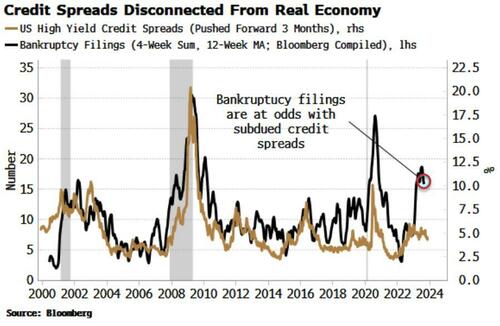
Authored by Simon White, Bloomberg macro strategist,
Pharmaceutical company Mallinckrodt plans to file for Chapter 11 bankruptcy today. It’s a reminder, though, that bankruptcy filings in the US remain high.
Subdued credit spreads fail to reflect the rising incidence of corporate distress.
The Mallinckrodt news prompted me to refresh my chart on credit spreads with Bloomberg-compiled US bankruptcy filings. Filings remain elevated, and are higher than they have been in almost 25 years outside of 2008 and 2020. Filings typically to lead to a rise in the official number of Chapter 11 cases.
As the chart shows, it’s unusual for credit spreads to remain so muted when filings are so high.
Private credit is perhaps stifling price discovery in the traded credit markets.
Its size, now in the region of $1.5 trillion, has ballooned in recent years.
With the price and performance of transactions opaque, it will take longer for the market to become more broadly aware of lenders in trouble.
Credit spreads are therefore less likely to be a true reflection of underlying conditions; they are thus prone to an abrupt repricing when they do.
Authored by Simon White, Bloomberg macro strategist,
Pharmaceutical company Mallinckrodt plans to file for Chapter 11 bankruptcy today. It’s a reminder, though, that bankruptcy filings in the US remain high.
Subdued credit spreads fail to reflect the rising incidence of corporate distress.
The Mallinckrodt news prompted me to refresh my chart on credit spreads with Bloomberg-compiled US bankruptcy filings. Filings remain elevated, and are higher than they have been in almost 25 years outside of 2008 and 2020. Filings typically to lead to a rise in the official number of Chapter 11 cases.
As the chart shows, it’s unusual for credit spreads to remain so muted when filings are so high.
Private credit is perhaps stifling price discovery in the traded credit markets.
Its size, now in the region of $1.5 trillion, has ballooned in recent years.
With the price and performance of transactions opaque, it will take longer for the market to become more broadly aware of lenders in trouble.
Credit spreads are therefore less likely to be a true reflection of underlying conditions; they are thus prone to an abrupt repricing when they do.
Loading…






